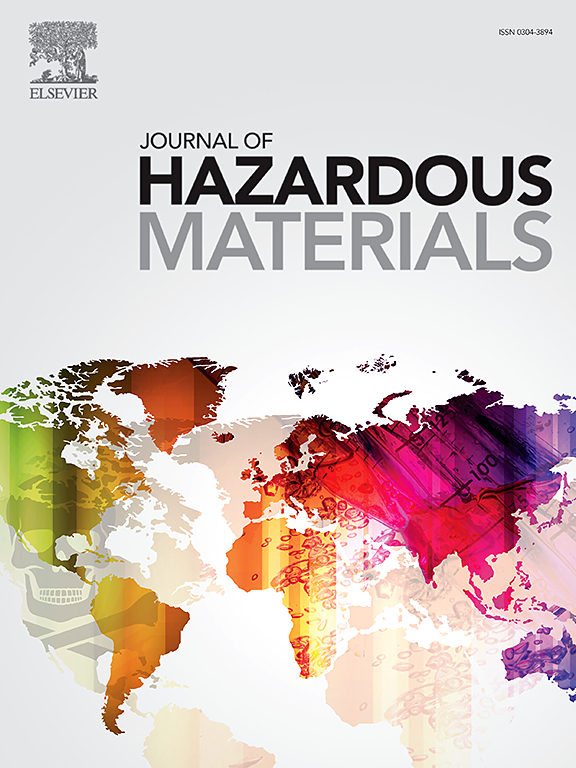封闭式固定床细菌-藻类生物膜反应器:含酚废水处理和资源转化的可行解决方案
IF 11.3
1区 环境科学与生态学
Q1 ENGINEERING, ENVIRONMENTAL
引用次数: 0
摘要
采用新型密闭固定床细菌-藻类生物膜反应器(CF-BABR)处理含酚废水,提高酚类物质的资源化转化率。CF-BABR具有较强的抗冲击负荷能力和稳定的降解效率,在0 ~ 150 mg/L的浓度范围内可完全降解酚类化合物。从流入到流出,细菌的有效序列、丰度和多样性呈下降趋势。氯杆菌是降解酚类污染物的优势菌。真菌丰度逐渐下降,多样性逐渐增加。Kalenjinia和皮三磷酸体在降低污染物毒性方面具有协同作用。高浓度的污染物导致微藻群落丰度较高,其中风景藻科成为最占优势的藻类科,这与酚类化合物的降解呈正相关。功能基因预测表明,细菌中功能基因的丰度沿废水流动总体下降。碳水化合物代谢和氨基酸代谢是最活跃的次级途径。在真菌中,预测基因功能在上游区域的丰度最高。代谢中间体如有机酸及其衍生物、脂类和类脂分子、羧酸及其衍生物等均显示出CF-BABR对酚类化合物的降解作用。本文章由计算机程序翻译,如有差异,请以英文原文为准。

Closed Fixed-Bed Bacteria-Algae Biofilm Reactor: A Promising Solution for phenol containing wastewater Treatment and Resource Transformation
This study focuses on treating phenolic wastewater with a novel closed fixed-bed bacteria-algae biofilm reactor (CF-BABR) to enhance resource transformation for phenolic substances. The CF-BABR showed strong impact - load resistance and stable degradation efficiency, fully degrading phenolic compounds at concentrations from 0 - 150 mg/L. From the inflow to the outflow, the effective sequences, abundance, and diversity of bacteria decreased. Chlorobaculum was the dominant bacterium for phenolic pollutant degradation. The abundance of fungi decreased gradually, while their diversity increased. Kalenjinia and Cutaneotrichosporon played a synergistic role in reducing pollutant toxicity. The high - concentration pollutants at the influent led to a higher abundance of microalgal communities, and Scenedesmaceae became the most dominant algal family, which was positively correlated with the degradation of phenolic compounds. Functional gene prediction indicated that the abundance of functional genes in bacteria decreased overall along the wastewater flow. Carbohydrate metabolism and amino acid metabolism were the most active secondary pathways. In fungi, the predicted gene functions had the highest abundance in the upstream region. Metabolic intermediates such as organic acids and derivatives, lipids and lipid - like molecules, and carboxylic acids and derivatives demonstrated the degradation effect of CF-BABR on phenolic compounds.
求助全文
通过发布文献求助,成功后即可免费获取论文全文。
去求助
来源期刊

Journal of Hazardous Materials
工程技术-工程:环境
CiteScore
25.40
自引率
5.90%
发文量
3059
审稿时长
58 days
期刊介绍:
The Journal of Hazardous Materials serves as a global platform for promoting cutting-edge research in the field of Environmental Science and Engineering. Our publication features a wide range of articles, including full-length research papers, review articles, and perspectives, with the aim of enhancing our understanding of the dangers and risks associated with various materials concerning public health and the environment. It is important to note that the term "environmental contaminants" refers specifically to substances that pose hazardous effects through contamination, while excluding those that do not have such impacts on the environment or human health. Moreover, we emphasize the distinction between wastes and hazardous materials in order to provide further clarity on the scope of the journal. We have a keen interest in exploring specific compounds and microbial agents that have adverse effects on the environment.
 求助内容:
求助内容: 应助结果提醒方式:
应助结果提醒方式:


